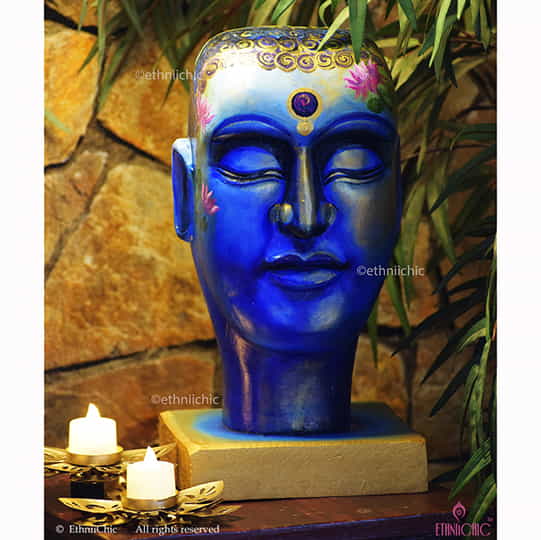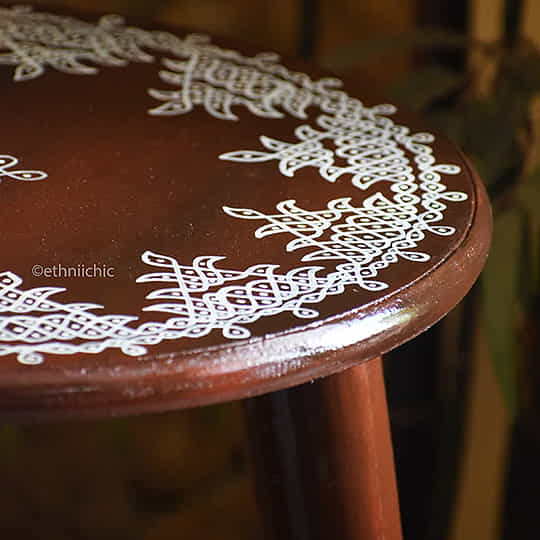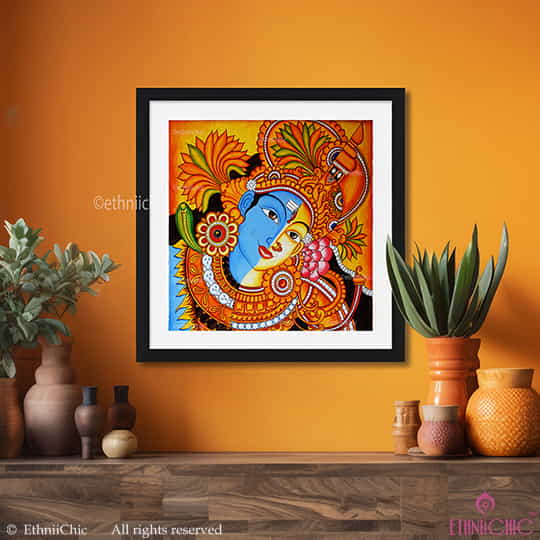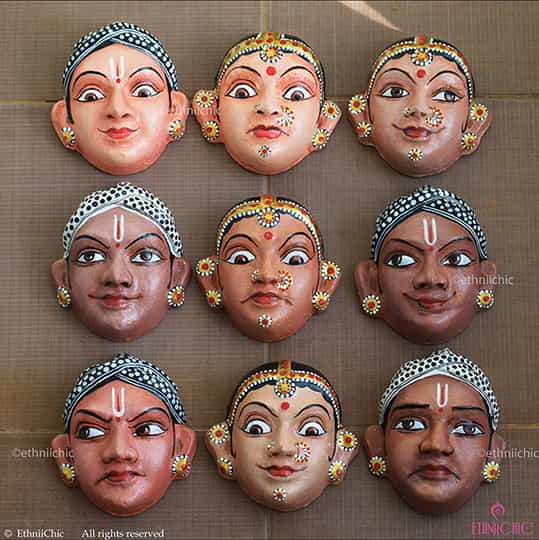“Aham Brahmasmi” – The Sculpture That Spoke Back to Me
Inspiration: A Moment of Stillness
There are some pieces that come from the head. And then, there are those that come from somewhere much deeper, from the silence between thoughts, from a place where you stop being the creator and simply become the channel. This Buddha sculpture was one such piece.
The idea first came to me in a moment of quiet reflection. I wasn’t planning anything ornate or complicated, just sitting with the thought of stillness. In that pause, a vision emerged: the Buddha, not just as a figure of peace, but as a bridge between the formless and the form. I sketched without hesitation, and what unfolded surprised even me.
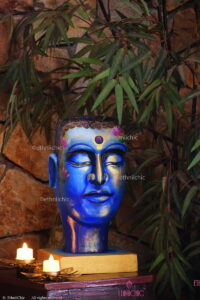
The Face, The Lotus, and the Inner Journey
The face of the Buddha is where the journey begins. Carved with sublime gentleness, the expression emanates calmness that transcends emotion. The eyes are half-closed, suggesting a gaze that is turned neither outward nor inward but toward the space in between, the space of still awareness.
The expression is one of subtle joy, not derived from fleeting pleasure, but from a peace that comes with understanding the nature of impermanence. It is the face of someone who has seen beyond the veil of illusion and rests in the clarity of truth.
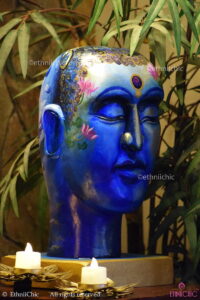
The lotus – a motif I’ve always found powerful, painted delicately near the face, is not merely an adornment but a profound metaphor, it is the visual echo of the Buddha’s realization. Rising unsullied from the murky depths, it mirrors the awakened mind that blooms in the midst of worldly suffering, the perfect metaphor for the human journey of how awakening happens through suffering and not despite it. Suffering and confusion, like the mud, are not obstacles to enlightenment; they are the very conditions that make it possible.
In this piece, the lotus near the serene face serves as a quiet reminder that divinity is not beyond us, but within us, waiting to bloom. It’s a tribute to resilience and to the silent power of transformation.
“Aham Brahmasmi”: The Crown of Realization
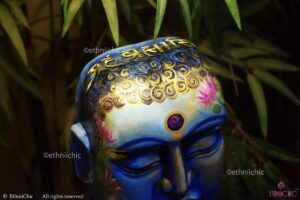
What made this sculpture truly personal for me was the crown. I inscribed it with the Sanskrit words “Aham Brahmasmi”, I am Brahman. This declaration, one of the four Mahavakyas from the Upanishads, rooted in the Advaita Vedanta tradition, often translated as “I am the Absolute.” dissolves the boundary between the individual and the infinite.
In the context of the Buddha sculpture, it signifies the culmination of the inward journey: the recognition that the self, purified of illusion, is not separate from the Absolute. The placement of this phrase on the crown is deeply intentional. It is at the apex of the form that we encounter the apex of realization.
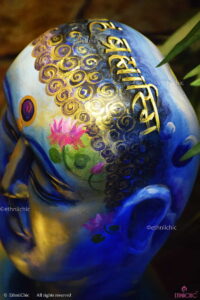
To me, it encapsulates the spiritual essence of India, that deep realization of oneness, where the boundary between ‘I’ and the universe dissolves. Painting this phrase felt less like adding ornamentation and more like revealing truth.
The Cosmic Mandala Behind the Mind
But perhaps the most unexpected part of this sculpture is what sits behind the head. Behind the Buddha’s head, a hand-painted mandala-like aura glows. I painted an abstract halo., not a literal one, but a circular, cosmic design that pulses with life. It’s not just a decorative backdrop; it’s an extension of consciousness. Drawing inspiration from the cosmic art seen in ancient Indian temples, especially the Ajanta and Ellora caves, it symbolizes the vibration of an enlightened presence . 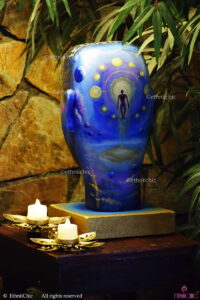
This visionary painting is a profound meditation on the soul’s journey toward transcendence and unity with the divine source. At its heart, a lone figure ascends from a swirling, cloud-like foundation symbolizing the illusions and density of the material world into a realm of radiant light and cosmic order.
The brightness emanating from the center, where the figure is ascending, symbolizes the inner awakening or realization of truth. It marks the moment of spiritual illumination, where the ego dissolves and the soul recognizes its oneness with the infinite. The concentric circles of golden light suggest stages of enlightenment, sacred geometry, and the unfolding nature of consciousness itself.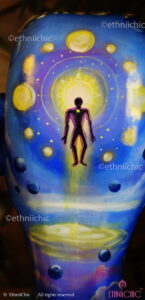
This sacred geometry serves as both a visual halo and a representation of inner balance, echoing the meditative energy of the sculpture. This backdrop was meant to be more than visual framing it became an extension of the Buddha’s aura, the vibrations of stillness made visible.
The orbs and celestial bodies surrounding the figure reinforce the idea that this journey is not solitary, but part of a greater cosmic dance. The scene invites contemplation of our place in the universe, not as isolated beings, but as luminous expressions of a much vaster, interconnected reality.
From Blue to Gold: A Visual Metaphor for Enlightenment
The color palette is not merely aesthetic, it is symbolic. Deep blues and purples dominate the periphery, representing the mystery of the unknown, the subconscious, and the vast potential of the cosmos. As one moves inward, these colors give way to warm golds, yellows and whites, tones often associated with wisdom, divinity, and purity.
The transition from cool to warm hues visually narrates the soul’s movement from ignorance to understanding, from fragmentation to wholeness. This transition suggests that from the depths of introspection (blue), one ascends into the radiance of awakened being (gold). It is the alchemy of meditation: silence turning to light.
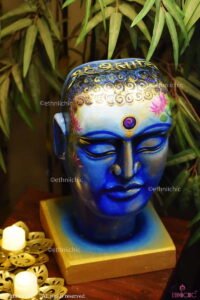
Then there’s the base, where midnight blue gently merges into radiant gold. It wasn’t just a color transition, it’s symbolic of the journey from ignorance to awareness, from the depths of the unknown into the golden light of consciousness.
- Blue like the sky or the ocean, represents introspection, the subconscious, and the vast expanse of the inner world.
- Gold stands for wisdom, realization, and the light of awakened consciousness.
As the colors merge, they reflect the path of spiritual growth from stillness and seeking, to radiance and realization. It’s the journey of the seeker becoming the seer.
Why This Belongs to Ethniichic
At Ethniichic, we believe art is not just something to look at, it’s something to live with. we celebrate not just handmade decor, but storytelling through art. This piece is more than a sculpture, it’s a spiritual companion, a visual mantra, and a daily reminder of our inner truth. This sculpture is a deeply personal expression of our brand’s ethos: merging Indian tradition with soulful, handcrafted design.
It resonates with our belief in heritage-inspired, soulfully crafted Indian home decor. Every brushstroke and curve is hand-finished, rooted in traditional Indian philosophy, but expressed with a contemporary design language.
Whether you’re curating a meditation corner, styling a conscious living space, or looking for a meaningful spiritual gift, this piece is a reminder of your own inner light.
Closing Thoughts
In contemplating this sculpture, we are not merely admiring an aesthetic achievement. We are engaging with a philosophical mirror. It reflects to us not what we are, but what we might become when the mind is stilled, the heart opened, and the self seen clearly. It invites us to sit, to breathe, to notice and to remember that beneath the ever-changing forms of our lives lies a stillness untouched by time.
This wasn’t just a product I designed. It was a moment I lived a moment that became form. And now, I’m honoured to share it with those who resonate with its energy.
This Buddha, then, is not a figure of the past. It is a presence. A silent radiance. A reminder that within each of us blooms a lotus, and above each of us glows the silent truth: Aham Brahmasmi.
🕉️ Aham Brahmasmi. You are That.


